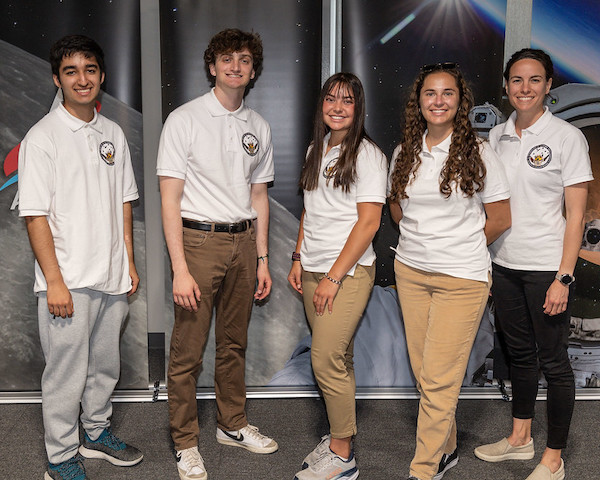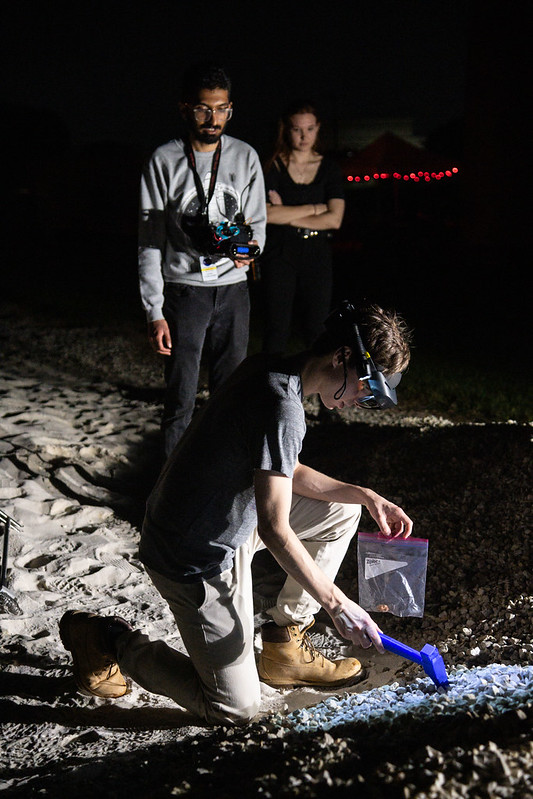
Student teams submitting top proposals will be picked to develop software, be mentored by NASA experts and test their devices in an analog mock EVA scenario at the Johnson Space Center.
Latest News
November 29, 2023
NASA’s Spacesuit User Interface Technologies for Students (SUITS) competition challenges students to design and create spacesuit information displays within augmented reality (AR) environments. As NASA pursues Artemis—landing American astronauts on the Moon—the agency will accelerate investing in surface architecture and technology development.
Crew members on spacewalks are equipped with the appropriate human autonomy-enabling technologies necessary for the elevated demands of lunar surface exploration and extreme terrestrial access. The SUITS 2023 Challenges target key aspects of the Artemis mission.
The challenge is calling on college students throughout the country to build software and augmented reality design solutions to inspire future displays for crew members in later Artemis missions.
The main goal for NASA SUITS is creating an innovative spacesuit user interface (UI) that leverages AR. The UI demonstrates how AR can be used in a crew member’s display during extravehicular activity (EVA) operations in a non-obtrusive way. The design also may implement peripheral devices such as control devices, navigation sensors, network-connected devices, robotics and cameras.
NASA provides the Virtual Instrument for Simulating Inertial Objects (VISION) kits. With these kits, teams simulate lunar vehicles, various EVA equipment and points of interest. The crew members wearing the head-mounted display are required to have a VISION kit on them for the rover recall function and various other tasks.

In a lunar extravehicular activity, or moonwalk scenario, crew members don a next-generation spacesuit and egress the lander from the airlock. Images courtesy of NASA.
The VISION kit contains a Raspberry Pi with global positioning system hardware, an inertial measurement unit, an external antenna and a power supply. Data streamed from the kit includes inertial measurement and location data. For example, the provided data could include its current position, in world and local coordinates, its local speed, and its bearing. The team is responsible for displaying the information given to them via the telemetry stream.
Jaime Semple is the activity manager for NASA’s Office of STEM Engagement. We spoke to Jaime to learn more about this event. Here’s how our conversation went.
Digital Engineering: Can you provide an overview of the NASA SUITS competition, how it came to be, and the intent of the program? Who will be participating or who has participated?
Jaime Semple: NASA SUITS is a collaboration between the Extravehicular Activity and Human Surface Mobility Program and the Office of STEM Engagement. NASA SUITS began when the EVA office began looking at how augmented reality (AR) could revolutionize the human experience in space. There are two main goals for SUITS, which are to provide authentic project-based design experience to students, and to provide workforce development for future and current needs in aerospace.
SUITS participants are undergraduate and graduate students from U.S. institutions of higher learning. SUITS selects 10 teams each year and typically has around 180 students involved. In 2023 our 10 teams hail from 15 institutions including five minority-serving institutions and four community colleges.
DE: Can you tell us about some of the designs that are part of the event and how they came to be?
Semple: Students create displays and controls for potential use on future spacesuits. This includes telemetry data like oxygen levels, suit pressures, fan speeds and temperatures. Teams also design navigation solutions, computer vision tasks, rover control and aid astronauts in scientific data collection such as lunar geology.
Teams are provided with a mission description and then set free to create their own interpretation of a solution. We want to see out of the box but well-thought-out ideas.
DE: Can you provide some examples of what the event has produced or what you expect it to produce?
Semple: Here is a YouTube post from a Twitch stream of one of our teams doing a test run. NASA SUITS teams have also written numerous academic papers.
Jim Romeo is a freelance writer based in Chesapeake, VA. Send e-mail about this article to [email protected].
Subscribe to our FREE magazine, FREE email newsletters or both!
Latest News
About the Author
Jim Romeo is a freelance writer based in Chesapeake, VA. Send e-mail about this article to [email protected].
Follow DE





